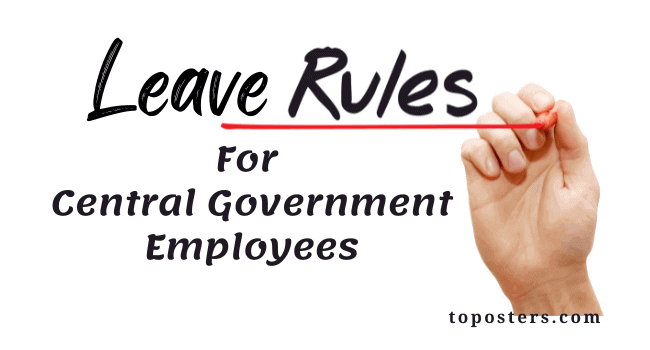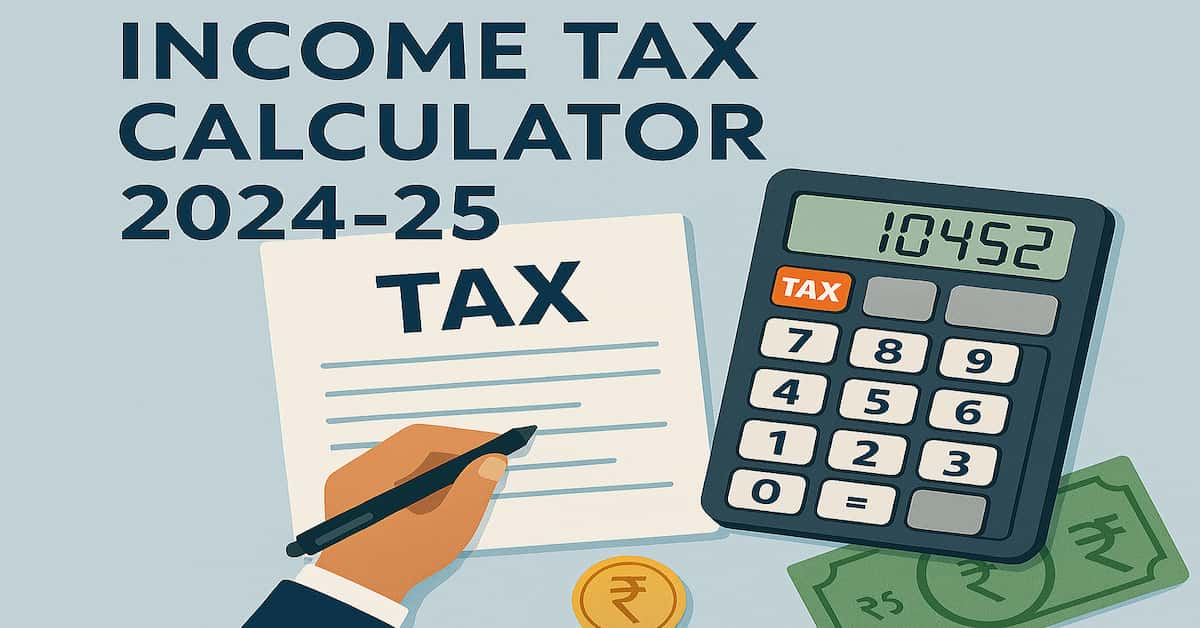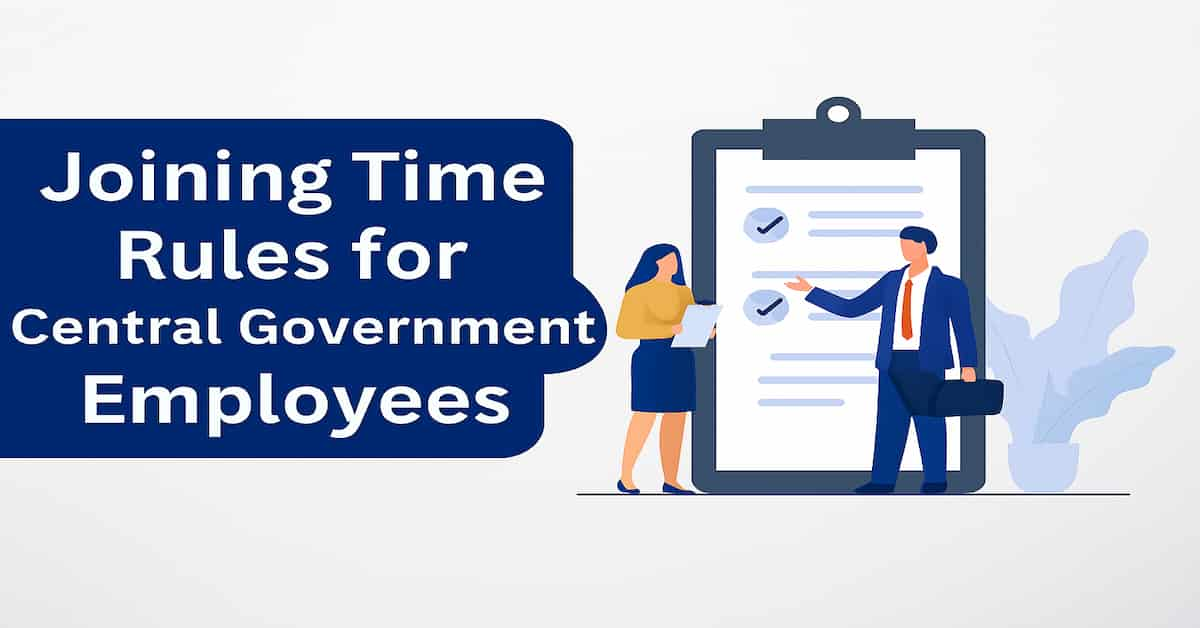Leave rules for central government employees are governed by the Central Civil Services (Leave) Rules, 1972 and form an important aspect of their employment contract.
Sometimes a government employee applies for leave but due to lack of good knowledge of leave rules for Central Government Employees, he is not able to take full advantage of the leave.
As we know that various types of leave are provided to government employees by the central government as per their need . But not all employees are aware about these leave, especially those employees who have newly joined a government office.
If you are a central government employee, you must follow these leave rules. Failure to adhere to these rules can lead to some severe consequences.
The most important types of leave for Central Government Employees are-
1. Earned Leave 2. Half Pay Leave 3. Commuted Leave 4. Maternity Leave 5. Paternity Leave 6. Child Care Leave 7. Casual Leave 8. Study Leave
In this blog, we will explore the different types of leave available to Central Government Employees, the conditions for availing each type of leave, and the process for applying for leave.
Whether you are an existing Central Government employee or looking to join a Government job, this post will provide you valuable information on the leave rules and regulations governing your employment. So, read this complete article to know more about the different types of leaves available for the Central Government employees.
Also read: Earned Leave and Encashment of Earned Leave for Central Government Employees Leave Travel Concession for Government Employees
Leave Rules for Central Government Employees

Leave rules for Central Government Employees are governed by the Central Civil Services (Leave) Rules, 1972.
The important types of leave availed by most of the government employees are Earned Leave, Half Pay Leave, Commuted Leave, Maternity Leave, Paternity Leave, Child Care Leave, Study Leave and Casual Leave. These types of leave are provide by Central Civil Services (Leave) Rules, 1972.
We are going to tell the important Leave rules for Central Government Employees and explain all these types of leave one by one.
Earned Leave rules for central government employees
Earned Leave is very important for any central government employee. This leave is earned by a government employee i.e. earned leaves are credited to his leave account in lieu of working days.
30 Earned Leaves are credited to leave account of a government employee in a year i.e., 2.5 Earned Leave in a month. Accordingly, 15 Earned Leaves are credited in advance on the 1st of January and 1st of July every year.
A maximum of 300 Earned Leaves can be accumulated in the leave account of a government employee. But these 300 Earned Leave will be in addition to the number of days for which he has encashed along with Leave Travel Concession during his service period.
When a fresh recruit joins the government office, then in the half year in which he joins, 2.5 earned leaves will be credited to his leave account for each completed month till the completion of that half year. If credited leave in fractions of a day, then it should be rounded off to the nearest day. For example, if Earned Leaves is 9.5 then it will be 10 days.
If a government employee is transferred to another office and does not avail joining time at the time of transfer, if admissible, then the joining time will be credited to his earned leave account.
If he avails a few days out of the admissible joining time then the remaining days are credited to his earned leave account. But after adding the joining time to his earned leave account, the total number of accumulated earned leave should not exceed 300 days. Also, these 300 days are in addition to the number of days for which encashment has been allowed along with LTC.
When a government employee is transferred to another office within the same station then he is eligible for one day joining time. If he does not avail this joining time, it cannot be credited to his earned leave account.
A government employee can avail maximum up to 180 days earned leave at a time. But in some cases Group ‘A’ and Group ‘B’ officers can avail more than 180 days but not exceeding 300 days at a time provided these leaves (excess of 180 days) are spend in outside India, Bangladesh, Bhutan, Burma, Sri Lanka, Nepal and Pakistan.
If a government servant is due to retire, he may avail Earned leave up to 300 days at a time as leave preparatory to retirement.
Half Pay Leave rules for Central Government Employees
20 days for each completed year are credited as Half Pay Leave in advance to a government employee’s leave account, 10 days on the 1st of January and 10 days on 1st of July every year i.e. 5/3 days for each completed calendar month. The fraction of Half Pay Leave will be rounded off to the nearest day.
If a government servant is due to retire or resigns from service then Half Pay Leave is credited at the rate of 5/3 days for each completed calendar month up to the date of retirement or resignation in that half-year.
In the case of death of a government employee during service period, Half Pay Leave is credited at the rate of 5/3 days for each completed calendar month up to the date of death. In the case of removal or dismissal from service, Half Pay Leave is credited at the rate of 5/3 days for each completed calendar month up to the end of the calendar month preceding the last calendar month of service.
As per rule 29(4) of FRSR (Leave Rules), a government servant can avail Half Pay Leave either with or without medical certificate.
Commuted Leave rules for central government employees
Commuted leave is not a separate type of leave, but only half pay leave is converted into commuted leave as per the requirement.
A government employee can avail commuted leave on the basis of medical certificate which is not exceeding half the amount of half pay leave. For example, if a government employee has 50 half pay leave in his leave balance then he can avail up to 25 commuted leave.
Commuted leave can be availed even without medical certificate subject to the following conditions-
1. A government servant can avail up to a maximum of 90 days during his entire service period for an approved course of study certified to be in public interest. 2. A female Government servant can avail up to a maximum of 60 days in continuation of maternity leave. 3. A female Government servant can avail up to a maximum of 60 days if she adopts a child less than one year old and she has less than two living children.
A government servant, who has earned leave balance, can request for commuted leave and the same may be granted by competent authority.
Maternity Leave Rules for central government employees
Maternity leave is provided to a female employee to take care of herself during pregnancy. Female employees who have less than two living children are eligible for maternity leave.
Maternity leave for a period of 180 days from the date of its commencement may be granted to eligible female employee by a competent authority. In the case of miscarriage including abortion, the maternity leave not exceeding 45 days.
During the maternity leave period, she will be eligible for full pay leave salary which is equal to the pay drawn by her immediately before proceeding on leave.
Maternity leave is also provided separately, hence it will not be debited from leave account.
Maternity leave may be combined with leave of any other kind. In continuation of the maternity leave, any leave may be taken without medical certificate up to two years including commuted leave up to 60 days and leave not due.
Paternity Leave rules for central government employees
The male government servant is also provided a separate leave to take care of his children, which is called paternity leave.
A male Government servant who has less than two surviving children is eligible for Paternity Leave. He is also eligible for Paternity Leave in the case valid adoption of a child below the age of one year. If the leave is not availed by the government servant within this period, it should be tread as lapsed.
He can avail paternity leave up to 15 days before delivery or up to six months from the date of delivery of the child. He is also eligible for 15 days paternity leave from the date of valid adoption of a child.
During the paternity leave he will be paid Leave Salary equal to the last pay drawn and no leave will be deducted from his leave account.
Child Care Leave rules for central government employees
If a female government servant has minor children, she may be granted Child Care Leave for taking care of her children. She can also avail child care leave to take care of other needs like examination, illness etc.
She may be granted child care leave for a maximum period of 730 days during her entire service for taking care of up to two children.
A single male parent is also eligible for availing child care leave.
A female government servant / a single male parent is not eligible for Child Care Leave if child is eighteen years of age or older.
Leave salary will be paid to government employee during the period of Child Care Leave and it is equal to the pay drawn immediately before proceeding on leave.
Child Care Leave can be availed in more than one spell. This leave is also provided separately and will not be deducted from leave account.
If a government employee has availed 730 days i.e. 2 years in one spell and want to continue for third year then she / he may be allowed for the third year as leave not due and commuted leave up to 60 days (without production of medical certificate).
Casual Leave Rules for central government employees
Casual Leave is not a recognized form of leave and is not subject to any rules made by the Government of India. The maximum amount of Casual Leave admissible to the Central Government employees is 8 days in a calendar year.
A government employee may be allowed to avail maximum up to 5 days casual leave in one spell, except under special circumstances. Casual Leave can be taken for half-day also. A government employee on Casual Leave is not treated as absent from duty and pay is not intermitted.
Casual Leave can be combined with only Special Casual Leave or Vacation. This cannot be combined with any other kind of leave. Also It cannot be combined with joining time.
Sundays and Holidays falling during a period of Casual Leave are not counted as part of Casual Leave. Sundays/public holidays/restricted holidays/weekly offs can be prefixed/ suffixed to Casual Leave.
Casual Leave can be taken while on tour, but no Daily Allowance will be admissible for the period.
A government employee can avail LTC during Casual Leave.
Download Central Civil Services (Leave) Rules, 1972 pdf
Conclusion
Leave rules for Central Government employees are governed by the Central Civil Services (Leave) Rules, 1972.
These rules outline the different types of leave that are available to central government employees viz Earned Leave (EL), Half Pay Leave (HPL), Maternity Leave, Paternity Leave, Medical etc and the conditions under which each type of leave can be availed.
FAQs about Leave Rules for Central Government Employees
How many types of leave are available to Central Government employees?
The most important types of leave for Central Government Employees are-
1. Earned Leave 2. Half Pay Leave 3. Commuted Leave 4. Maternity Leave 5. Paternity Leave 6. Child Care Leave 7. Casual Leave 8. Study Leave
How much Earned Leave (EL) can a Central Government employee accumulate?
A Central Government employee can accumulate up to a maximum of 300 days of Earned Leave (EL).
How much Half Pay Leave (HPL) can a Central Government employee avail?
A Central Government employee can avail up to a maximum of 180 days of Half Pay Leave (HPL).
Can CL and EL be taken together?
No, CL (Casual Leave) and EL (Earned Leave) cannot be taken together.
Can we take CL on Friday and EL on Monday?
No, you cannot take. If you do this then it will be like combining EL and CL and both of them cannot combined.
Can Medical leave and casual leave be combined?
Casual leave cannot be combined with any other kind of leave admissible
under Central Civil Services (Leave) Rules, 1972.



